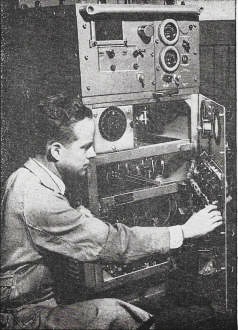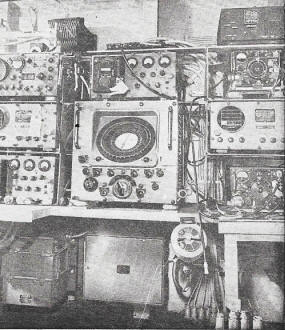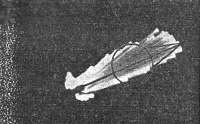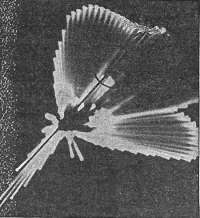Anti Radar Equipment
|
|
The General Electric TDY-2 was one of the earliest American anti-radar electronic countermeasures (ECM) systems. Having been highly secret technology during World War II, its existence and some details of its operation were revealed in a 1946 issue of Radio-Craft magazine. Declassification of much advanced technology in the post-war years fueled the boom in both commercial and consumer markets, including electronics, communications, automotive, boating, aircraft, appliances, construction, and even manufacturing and distribution. Interestingly, the time taken to get products into the marketplace was longer than a lot of people anticipated, and it caused consternation amongst those hoping to benefit from the promises made by companies toward the end of the war (see Radio Industry Unfair?). Anti Radar Equipment - Cover Feature Photo A - Ultra-high-frequency anti-radar transmitter partly open to view. Photo courtesy General Electric Co. The genius of America's big transmitter manufacturers - now engaged in producing new high-power, high-frequency equipment for FM, television and communications use - was devoted up to a few months ago to producing very similar transmitters for the purposes of electronic war. The radar jamming transmitter shown on our cover contains many of the features required in peacetime u.h.f. apparatus. A product of General Electric, it is known as the TDY-2. Unfortunately, the military use of the apparatus prevents - even at this late date - publication of facts concerning the exact power or frequency of the transmitter, though the magnetron tubes used by it give the reader a rather good idea of the latter. In all the pictures of the apparatus yet released, the top shelf, which carries the power oscillator and modulator, is modestly closed. The more prosaic power equipment may be seen in the accompanying Photo A. The four tubes which are visible on the top shelf of the lower section are high-voltage rectifiers. Transformers, chokes and other heavy equipment are on the bottom shelf. The water pump, used for cooling; may be seen behind the engineer's arm. A special antenna which permitted rotation in any direction, as well as variations in vertical polarization, was used with this unit. A special "antenna pedestal" was required, this consisting of a lower stationary part, and the rotating mast which carried two antennas. The pedestal control-indicator unit both rotates the antenna mast and indicates the bearing in which jamming signals are transmitted. Another important part of the anti-radar campaign consisted of detecting and locating enemy stations, both mobile and fixed (so that jamming signals could be accurately beamed on them). This device, a great improvement on standard pre-war direction finders, used a cathode-ray indicator like that in a radar set itself. One of these direction finders, manufactured by the Submarine Signal Co., of Boston, Mass., is shown in Photo B. It measures the frequency of the signal as well as the direction from which it came, and could receive successfully even the ultra-high-frequency signals produced by the very latest radar apparatus. Other apparatus of the radar counter-measures room, seen around the direction finder, consists largely of receivers tuned to different portions of the radio spectrum. Operators handling the new direction finders became so skilled that they could look at the scope and tell from the image of the intercepted signals what kind of radar had produced them. It was possible to distinguish between images caused by anti-aircraft, surface search and gun-control radars. Thus in many cases it was possible to deduce the size and class of the ship carrying the intercepted radar. Patterns on the screen when one signal, and when several signals on the same frequency, are present, appear in Photos C and D. This capability of occasionally identifying the source of signals was at times embarrassing to the operators of the radar-finder. In one case during night maneuvers aboard a destroyer, signals were picked up which could be definitely identified as coming from a U. S. cruiser. This was accordingly reported to the bridge. When, some days later, U. S. cruisers were sighted, the captain felt that his direction-finder men had not been "on the job" because the cruisers' presence had not been detected! Other apparatus which was developed during the war but which is likely to have important applications in peace is the Loran system of locating a ship. This is superior to straight direction finding, as the ship operator can get his position exactly without having to communicate with the shore stations. Radar may be the most important peace-time aid to navigation, as it permits entry into crowded harbors at night or in dense fog with little more danger than in bright daylight. Even railroads are seriously considering the use of radar as a means of preventing rear-end collisions. The greatest problem, however, has been development of transmitters capable of putting out considerable power at microwave frequencies. It will be remembered that during the discussions on high-definition television which took place last year one of the chief objections was that it might take years to develop the transmitters required for the high frequencies involved. The equipment described here and pictured on the cover should be the answer to that problem. Not alone in television will such apparatus be useful - there are many applications in sound broadcasting and continuous wave or pulse telegraphy to which it is particularly adapted.
Posted May 14, 2021 |
|




